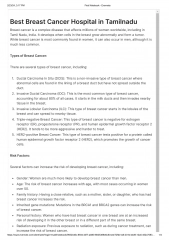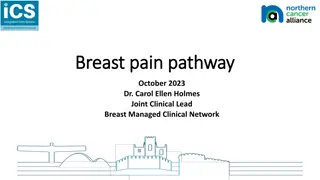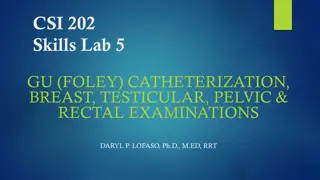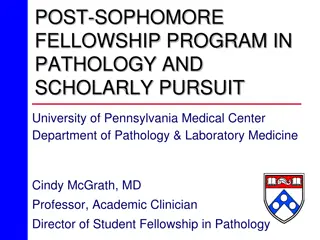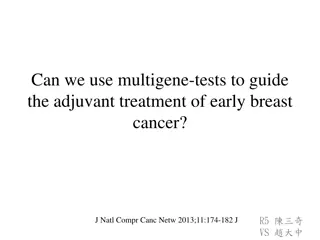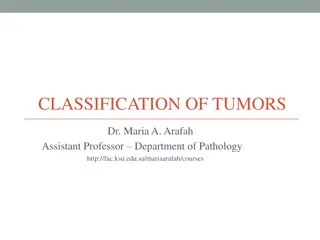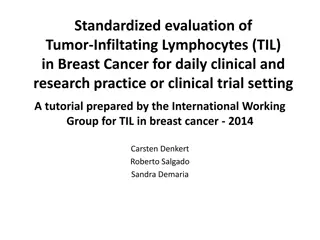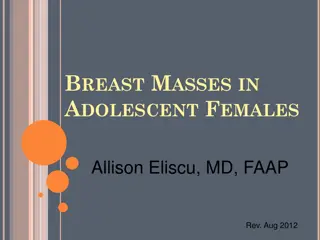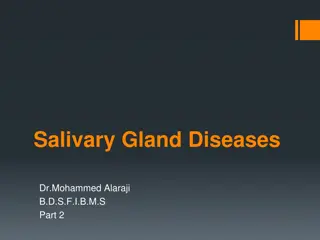Understanding Benign Breast Conditions: Clinical Presentations and Pathology
Benign breast conditions can manifest in various ways, including pain, palpable masses, and nipple discharge. Familiarity with common inflammatory conditions like mastitis and abscesses, as well as understanding fibrocystic changes and benign tumors such as fibroadenoma, is crucial. Mammographic screening aids in detecting breast abnormalities early. Differentiating between benign and malignant lesions requires clinical examination and history-taking. This overview also touches on the risk of subsequent breast cancer in women with diagnosed benign breast tissue.
- Benign Breast Conditions
- Clinical Presentation
- Inflammatory Breast Conditions
- Fibrocystic Changes
- Mammographic Screening
Download Presentation

Please find below an Image/Link to download the presentation.
The content on the website is provided AS IS for your information and personal use only. It may not be sold, licensed, or shared on other websites without obtaining consent from the author. Download presentation by click this link. If you encounter any issues during the download, it is possible that the publisher has removed the file from their server.
E N D
Presentation Transcript
Benign breast cancer Objectives: Know the ways that benign breast conditions can present clinically . Know the common inflammatory conditions of breast (mastitis and abscesses). Understand the pathology of fibrocystic changes. Know the common benign breast tumors with special emphasis on fibroadenoma and phyllodes tumor. Know the risk of subsequent breast cancer in women with diagnosed benign breast tissue. Black: Doctors slides. Red: Important! Light Green: Doctors notes Grey: Extra. Italic black: New terminology.
Know the ways that benign breast conditions can present clinically. Introduction The functional unit of the breast is the lobule, which is supported by a specialized intralobular stroma. Understand the picture below. The inner luminal epithelial cells produce milk during lactation. The basally located myoepithelial cells have contractile function to aid in milk ejection and also help support the basement membrane. The ducts are conduits a tube for milk to reach the nipple. The size of the breast is determined primarily by interlobular stroma, which increases during puberty and involutes with age. Each normal constituent is a source of both benign and malignant lesions Clinical Presentation of Breast Diseases Pain (mastalgia pain in the breast ) It is the most common breast symptom. May be cyclical (monthly with menses) or noncyclical. Diffuse cyclical pain has no pathologic significance. Non-cyclical pain can be caused by ruptured cysts or areas of prior injury or infection, or no specific cause. Although the great majority of painful masses are benign, about 10% of breast cancers present with pain. Palpable mass Nipple discharge Milky discharge: NOT associated with malignancy. Physiological during lactation Bloody or serous discharges: commonly associated with benign lesions but can rarely be due to a malignancy. -Note that all acini and ducts are line by two cell types 1)Epithelium (for milk production ) and 2)Myoepithelium (for milk ejection) . The blue dashed-line lining the ducts toward the lumen is the epithelium and the black dashed-line is the myoepithelium .
Cont.. Mammographic Screening : Mammographic screening was introduced in the 1980s as a means to detect small, non-palpable, asymptomatic breast carcinomas. The principal mammographic findings of breast carcinoma are densities/masses and calcifications: Densities (mass): Most tumors appear radiologically denser than the normal breast. Fibroadenomas and cysts can also present as densities That is why clinical examination and taking history is really important to differentiate . Calcifications: Calcium gets deposited in secretions, necrotic debris, or hyalinized stroma. It can be seen in benign and malignant conditions depending on there characteristics Calcifications in malignancy are usually small, irregular, numerous, and clustered. Mammographic screening has increased the diagnosis of DCIS which usually present as mammographic calcifications It is recommended to start mammographic screening at the age of 40 years Annually . -Note that :In mammogram every thing appears grey or white , but masses will appear denser ; meaning it will be brighter than the normal tissue s color . Benign Breast Lesions I. Inflammatory lesions Acute mastitisInflammation of the breast parynchema : Staphylococcus aureus infection is the most common organism. Periductal mastitis Mammary duct ectasia dilated ducts disease Fat necrosis: It is usually due to a mechanical or surgical trauma. Lymphocytic mastopathy (sclerosing lymphocytic lobulitis): It is seen in diabetic women. Granulomatous mastitis: It can be idiopathic, due to sarcoidosis or TB.
Know the common inflammatory conditions of breast (mastitis and abscesses). II. III. Benign stromal lesions Fibroadenoma AND Benign phyllodes tumors Benign epithelial lesions Non proliferative breast changes (fibrocystic changes) Proliferative breast disease without atypia Proliferative breast disease with atypia / Atypical hyperplasia Inflammatory lesions Mastitis Acute mastitis: Almost all cases of acute mastitis occur during the first month of breastfeeding. Staphylococcus aureus is the most common causative organism. The breast is erythematous and painful. Fever is often present. Periductal mastitis: This condition is not associated with lactation. However, there is a strong association with cigarette smoking. Benign Epithelial lesions i. Non-proliferative Breast changes (Fibrocystic changes): -What women feel during PMS , The breast Engorgement and enlargement is part of the (Fibrocystic changes). It is the most common disorder of the breast. Age: 20 - 55 years, decreases progressively after menopause because it is associated with hormones . The cause is not known but it is thought to be hormonal imbalances. It can produce palpable breast masses, mammographic densities or calcifications, or nipple discharge. It may also present with cyclical pain. It carries no increased risk for cancer. Three histological patterns are seen: One of them or any combination of the 3 . Cysts with apocrine metaplasia: cysts are lined by benign flattened to columnar epithelium (with focal apocrine metaplasia sometimes not always). In apocrine metaplasia the cells become large and have abundant eosinophilic cytoplasm. The cysts can rupture and cause inflammation.Ducts get dialted forming cysts , and those cysts are lined by the epethilim we just mentioned. Apocrine means that the cell obtains abundant eosinophilic cytoplasm . Fibrosis: contribute to the palpable firmness of the breast. Increase in stroma and collagen Adenosis: It is defined as an increase in the number of acini per lobule (adenosis can also be seen in pregnancy).
Understand the pathology of fibrocystic changes. Apical snouts Cystic apocrine metaplasia Cysts ii. Proliferative Disease Without Atypia They are incidental findings and rarely form palpable masses. They are detected as small mammographic densities. Risk for cancer is 1.5 2 times normal.very low The following entities are included in this category: Epithelial hyperplasia Sclerosing adenosis Complex sclerosing lesions/radial scar Papillomas Proliferative variant of fibrocystic disease. Epithelial Hyperplasia (usual ductal hyperplasia) The normal breast has a 2 layers of cells (epithelial and myoepithelial cells). Thus, epithelial hyperplasia is defined as the presence of more than 2 layers. Hyperplasia can range from mild, moderate and severe/florid. Both epithelial and myoepithelial cells proliferate. It can be seen in the ducts and the lobules. When it is seen in fibrocystic disease: it is called as proliferative type/variant of fibrocystic disease.
Know the risk of subsequent breast cancer in women with diagnosed benign breast tissue. Usual ductal hyperplasia Normal acinus Slit-like (irrigular spaces) is very important feature to differentiate between usual ductal hyperplasia and ductal hyperplasia with atypia. Sclerosing Adenosis It is commonly seen as an incidental microscopic finding but may occasionally present as a palpable mass that is mistaken clinically for cancer . Calcifications are commonly seen in the lesion, so even on mammography it can mimic cancer . It is almost always associated with other forms of fibrocystic change. Microscopically: adenosis and stromal fibrosis in the lobule which leads to compression and distortion of the lobule. Risk of cancer is 1.5-2 Complex Sclerosing Lesion (Radial Scar)same as scelrosing adenosis , but this one is smaller ! Radial scars are stellate lesions characterized by a central nidus of entrapped glands in a dense fibrotic or hyalinized stroma. The nidus is surrounded by radiating arms of epithelium with varying degrees of cyst formation and hyperplasia. Adenosis: increase in number of acini per lobule Sclerosing: the background will be fibrotic
Cont.. They typically present as an irregular mammographic density and closely mimic an invasive carcinoma both mammographically and clinically. The word "scar" refers to the morphologic appearance, and not a prior inflammation, trauma or surgery. Radial scar (complex sclerosing lesion ( Intraductal Papillomas It is a papillary tumor that arises from the ductal epithelium. It is more common in the large lactiferous ducts (present in the central part of the breast at the nipple) but can also occur in the small ducts in any quadrant of the breast. Large duct papillomas (central papillomas): usually solitary and situated in the lactiferous duct at the nipple. Patients present with bloody nipple discharge and sometimes a subareolar palpable mass. Small duct papillomas: commonly multiple and located deeper within the ductal system. Small duct papillomas have been shown to increase the risk of subsequent carcinoma.
Cont.. Proliferative breast disease with atypia (Atypical hyperplasia): Risk for cancer is 4 - 5 times normal Atypical hyperplasia is a cellular proliferation resembling ductal carcinoma in situ (DCIS) or lobular carcinoma in situ (LCIS) but lacking sufficient qualitative or quantitative features for a diagnosis of carcinoma in situ. Include two entities: i. ii. Atypical ductal hyperplasia Atypical lobular hyperplasia Atypical hyperplasia has some of the architectural and cytologic features of carcinoma in situ but lack the complete criteria for that diagnosis and is categorized as ductal or lobular in type. ALH we don t see the lumen ADH Cookie cut appearance -Atypical hyperplasia is a middle entity between benign and malignant . It doesn't t have enough quantitative features to be called carcinoma because it doesn't t involve the whole duct .
Cont.. summary Relative risk of development of invasive carcinoma Pathologic lesion comments Non-proliferative breast diseases (fibrocystic changes) do not have an increased risk. Fibrocystic disease Epithelial hyperplasia Sclerosing adenosis Complex sclerosing lesions/radial scar Papillomas Proliferative fibrocystic disease. Proliferative disease without atypia 1.5 to 2 times normal Proliferative disease with atypia 4.0 to 5.0 times normal ADH ALH 8.0 to 10.0 times normal DCIS LCIS Carcinoma in situ
Know the common benign breast tumors with special emphasis on fibroadenoma and phyllodes tumor Stromal Lesions Fibroadenoma : The most common benign tumor of the female breast. It is composed of benign proliferation of both epithelial and stromal elements. It can occur at any age, most common before the age of 30 years. Clinical presentation: firm, mobile lump ( breast mouse ). It may increase in size during pregnancy. It may stop growing and regress after menopause. The tumor is usually solitary but may be multiple and involve both breasts. The tumor is completely benign and they are almost never malignant. Treatment: lumpectomy (only the lump is removed) we don t remove the whole breast because it is separated from the breast and doesn't t invade it Grossly spherical nodules, sharply demarcated and circumscribed from the surrounding breast tissue and freely movable so it can be shelled out. The size varies between 1 cm to 10 cm in diameter. The cut surface is pearl-white and whorled.
Cont.. Histology: tumor is composed of a mixture of ducts and fibrous connective tissue. The lesion consists of a proliferation of intralobular stroma surrounding and often pushing and distorting the associated epithelium. The border is sharply delimited sharp. Increase in the stroma will push the ducts forming this glandular spaces Phyllodes Tumors : Phyllodes tumors can occur at any age, but most present in the 40s and 50s, that is 10 to 20 years later than the average presentation of a fibroadenoma. These tumors are much less common than fibroadenomas. Most present as large palpable masses (usually 3 to 4 cm in diameter). Phyllodes tumors are classified as: i. Benign phyllodes tumors: most (75%) phyllodes tumors are benign. ii. Low-grade phyllodes tumors: they tend to recur locally and rarely metastasize. Low grade=borderline iii. High-grade phyllodes tumors: they are uncommon and they behave aggressively with frequent local recurrences and can have distant metastases to lung, bone and brain. They have better a prognosis than invasive ductal carcinoma. Big size stroma unlike fibroadenoma ; it needs surgery ! Benign phyllodes tumors are fibro-epithelial tumors that have a leaf-like pattern and a cellular stroma. Strome > Adenoma , that what differentiates it from fibroadenoma.
Questions 1- A 30-year-old woman sustained a traumatic blow to her right breast. Initially, there was a 3-cm contusion beneath the skin that resolved within 3 weeks, but she then felt a firm, painless lump that persisted below the site of the bruise 1 month later. What is the most likely diagnosis for this lump? A- Abscess. B- Fat necrosis. C- Fibroadneoma. D- Sclerosing adenosis. ANS: B 2- A 34-year-old woman has noticed a bloody discharge from the nipple of her left breast for the past 3 days. On physical examination, the skin of the breasts appears normal, and no masses are palpable. There is no axillary lymphadenopathy. She has regular menstrual cycles and is using oral contraceptives. Excisional biopsy is most likely to show which of the following lesions in her left breast? A- Acute mastitis. B- Fibroadenoma. C- Intraductal papilloma. D- Phyllodes tumor. ANS: C 3-A 47-year-old woman has a routine health examination. There are no remarkable findings except for a barely palpable mass in the right breast. A mammogram shows an irregular, 1.5-cm area of density with scattered microcalcifications in the upper outer quadrant. A biopsy specimen from this area is obtained and microscopically shows ductal hyperplasia. Which of the following is the most appropriate option for follow-up of this patient? A- Cessation of smoking cigarettes. B- Continued screening for breast cancer. C- Performing a simple mastectomy. D- Testing for the BRCA1 oncogene. ANS: B, The increased risk doesn t warrant mastectomy.
Questions 4- A 27-year-old woman feels a lump in her right breast. She has normal menstrual cycles, she is G3, P3, and her last child was born 5 years ago. On examination a 2-cm, irregular, firm area is palpated beneath the lateral edge of the areola. This lumpy area is not painful and is movable. There are no lesions of the overlying skin and no axillary lymphadenopathy. A biopsy specimen shows microscopic evidence of an increased number of dilated ducts surrounded by fibrous connective tissue. Fluid-filled ducts with apocrine metaplasia also are present. What is the most likely diagnosis? A- Fibroadenoma. B- Fibrocystic changes. C- Infiltrating ductal carcinoma. D- Mammary duct ectasia. Ans: B 5- A 24-year-old woman is breastfeeding 3 weeks after giving birth to a normal term infant. She notices fissures in the skin around her left nipple. Over the next 3 days, a 5-cm region near the nipple becomes erythematous and tender. Purulent exudate from a small abscess drains through a fissure. Which of the following organisms is most likely to be cultured from the exudate? A- Candida albicans. B- Lactobacillus acidophilus. C- Listeria monocytogenes. D- Staphylococcus aureus. ANS: D A 58-year-old woman comes to the hospital for a routine examination. A screening mammogram shows a 0.5-cm irregular area of increased density with scattered microcalcifications in the upper outer quadrant of the left breast. Excisional biopsy shows atypical lobular hyperplasia. She has been on postmenopausal estrogen-progesterone therapy for the past 10 years. She has smoked 1 pack of cigarettes per day for the past 35 years. Which of the following is the most significant risk factor for the development of lobular carcinoma in patients with such lesions? A- Atypical cytologic changes. B- History of smoking. C- Hormone replacement therapy. D- Postmenopausal age. ANS: A
. Editing File Email: pathology436@gmail.com Twitter: @pathology436 References: Doctor s slides + notes, Robbins basic pathology 10th edition.


